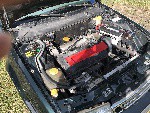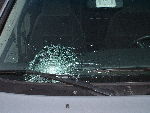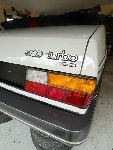
1999-2009 [Subscribe to Daily Digest] |
The most effective way of reducing body roll without affecting other ride parameters greatly would be to increase BOTH the front and rear anti roll bar's diameters. You will degrade single wheel ride events, but two wheel events should not be greatly affected.
I would advise putting the stiffest factory sway bar pair that fits in your vehicle. I advise using a factory setup as it is least likely to mess with the roll stiffness balance front to rear.
Probably an 02 or later Aero, but you should contact your dealer to ensure that 1) The Aero bars will fit. 2) Both of the Aero bars are of greater diameter than the both of the Linear bars
As far as how much difference it will make... I would advise test driving a new Aero and seeing if you are satisfied with it's roll gradient. If you feel it is not stiff enough, or just stiff enough in roll, changing only the bars will on your vehicle to Aero bars will not be a satisfactory solution for you.
Your car with Aero bars will roll more than an Aero. The Aero will have a lower roll gradient (º of body roll per g of lateral force) than your vehicle with Aero bars because it's Cg is lower and it will be even stiffer in roll than your vehicle with Aero bars because it still has stiffer springs.
If you change to the Aero bars and the end result is too soft in roll for you might want to consider changing to Aero Springs and Dampers. This will not also stiffen the ride a bit, but also lower the car. Both of these will reduce body roll.
So if an Aero is just stiff enough, or not stiff enough you are going to need to look to the aftermarket for even stiffer bars. Working for and OEM and talking with some friends at some aftermarket companies shows me that a lot of the aftermarket guys sell stuff that is not nearly as well engineered or balanced as the OEMs. I would advise the aftermarket as a last resort as I really don't trust many of them in the arena of suspension tuning. They believe and market stiffer as better for everything, and that is simply not the case.
If you elect to increase the diameter of one bar and not the other, you will change the limit handling of the vehicle. I would not advise doing that unless that is your goal. If you feel the vehicle has too much understeer at the limit, you might want to stiffen the rear a bit more than the front, if it is not understeer enough at the limit, you might want to stiffen the front more than the rear. Before you make this decision, make sure you are truly driving at the limit.
A little bit of background for those who are interested:
The roll gradient (º of body roll per g of lateral accel) is basically the parameter that quantifies how much the car will roll in a given corner. It is a function of the Cg height, the vertical distance from the Cg to the roll axis, and the roll stiffness. To minimize roll angle, the Cg should be as close to the roll axis as possible. If you wanted the car to "lean into the curve" you could locate the roll axis above the Cg. This actually wouldn't be a good thing but I will skip it for now. If there is interest I can post back later. In order to lower the CG without adding or reducing mass, you would need to lower the vehicle. This will drive the need for stiffer springs and dampers and in general degrade ride due to reduced jounce travel and the need for stiffer mainsprings to manage the loads in a shorter travel. Since you wanted to maintain ride, this is not an acceptable solution. As a side note, when you lower the car, the roll axis will also move.
OK so what you need to play with is roll stiffness. This is primarily a function of the springs, anti roll bars, tires, and bushings. To make it a little easier, we will assume that the bushings and tires are very stiff and do not contribute to the roll stiffness equation. The roll stiffness is a measure (usually in Newton meters per degree) of the amount of overturning torque that is required to roll the vehicle on its tires. The main items to tune this parameter are the spring stiffness and the roll bar stiffness. Increasing either one front or rear will increase the roll stiffness.
The big problem with tuning this at home is that the other main function of the anti roll bar is to help ensure safe limit handling by tuning the TLLTD (Total lateral load transfer distribution)
Regardless of how stiff your car is sprung or how much roll bar you have, or which direction your car leans when turning, load is transferred from the inside tires to the outside tires when rounding a turn. This is a potentially bad thing because of the way that tires work. The amount of load transferred from the inside tires to the outside tires is roughly proportional to the lateral force times the distance from the Cg to the ground, divided by the track width. There are some _small_ components I am ignoring that arise from the lateral shift of the Cg due to roll angle, but in practice that quantity is small.
How the above inner to outer load transfer gets distributed from front to back is what TLLTD is. It is controlled primarily by the relative heights of the front and rear roll centers and the relative stiffness of the front and rear suspensions in roll.
It is important to note and understand that the above shows that reducing or reversing body roll through either roll axis ht or roll stiffness changes will not change the total load transferred from the inside to outside wheels. That is a constant based on Cg height and track width (why low, wide, cars are good) What the suspension tuner can do is decide what percent of the load transfer will occur at the front of the vehicle and what percent will occur at the rear. (The percents always add up to 100 though...)
Since the backyard tuner doesn't usually much with suspension geometry to move roll centers, the easiest way to much with TLLTD is to play with stab bars or spring rates. Here is where it gets tricky. When the backyard guy buys a stab bar, all that is quoted are the OD and ID (ID only if hollow) Not the stiffness as installed in the vehicle. Moreover the backyard guy doesn't know the roll stiffness due to the main springs so changing roll bars and maintaining the roll stiffness balance front to rear is far from trivial since you aren't provided with the needed info. A lot of aftermarket guys run way too much roll stiffness in the rear because they think they are getting rid of excessive understeer. What they are often doing is causing limit oversteer.
I guess I should try to explain why TLLTD matters. To do this we have to think about tires for a minute. As you increase the normal force on a tire the lateral force it can develop increases, but at a decreasing rate. (1st der +, 2nd der -) (actually for a small range it usually increases linearly (2nd der 0, usually called "the linear range") and after that range the 2nd derivative becomes negative) An interesting thing that comes out of this is as you transfer weight from the inside to the outside, the overall cornering power of the vehicle will decrease.
Here is an example:
Lets take a car that initially was perfectly balanced and had 1000 N on each of it's four tires. We will also assume that the TLLTD is 50/50 for now. As we go around a corner let's say that the inside two tires are now supporting a vertical load of 900N and the outside two tires are supporting 1100N each.
Let us also assume that for at a given slip angle the tires are able to produce the following lateral forces for the following vertical forces.
Vert 800N Lat 800N
Vert 900N Lat 875N
Vert 1000N Lat 925N
Vert 1100N Lat 950N
Vert 1200N Lat 960N
In the balanced example above if the tires were equally loaded they would all be able to generate 925N for a total of 3700N, however due to load transfer the inside tire generate 875N each and the outside tires generate 950 each This gives a total of 3650N. For the perfectly balanced vehicle the effect of weight transfer from the inside to outside wheels is to lower the maximum cornering force the vehicle can achieve.
Now let us take a look at the example with all the roll stiffness up front and zero roll stiffness in the rear (zero roll stiffness isn't really possible because the wheels need mainsprings to keep the body up, but let's assume we are as soft in the rear as possible and ridiculously stiff in the front. (Replace roll bar with I beam from a high rise building)) In this case the total weight transfer from the inside to the outside will be the same, but it will all happen at the front. So now the inner front will carry 800N vertically, the outer front will carry 1200N vertically and the inner and outer rear will carry 1000 N each. Now the cornering power of the front will be less than that of the rear. Front = 800 + 960 =1760N. rear = 925 + 925 = 1850N. This would force the front tires to run at higher slip angles than the rears. This would be a generally understeer case and would decrease the overall cornering power but more so in the front.
In reality no car has all the cornering stiffness in the front or rear, but a balance is struck that gives what the OEM feels is an acceptable level of limit understeer under all loading conditions.
From a racing standpoint the best solution would be to have a TLLTD set up so that at the limit both the front and rear tires are working equally hard. This would generate the maximum possible lateral force. If the TLLTD favors the front, the front axle cornering power will be reduced and the vehicle will understeer at a lesser limit than the neutral case. If the TLLTD favors the rear, the rear axle cornering power will be reduced and the vehicle will oversteer at a lesser limit.
All of the above is way over simplified and based on some very rough assumptions. Even so it took quite a bit to try to explain it all. There are numerous other parameters that effect the vehicle under/oversteer. I was just attempting to explain anti roll bar's effects...
-Joe
posted by 65.60.2...
No Site Registration is Required to Post - Site Membership is optional (Member Features List), but helps to keep the site online
for all Saabers. If the site helps you, please consider helping the site by becoming a member.
 |
 |
 |
 |
 |



